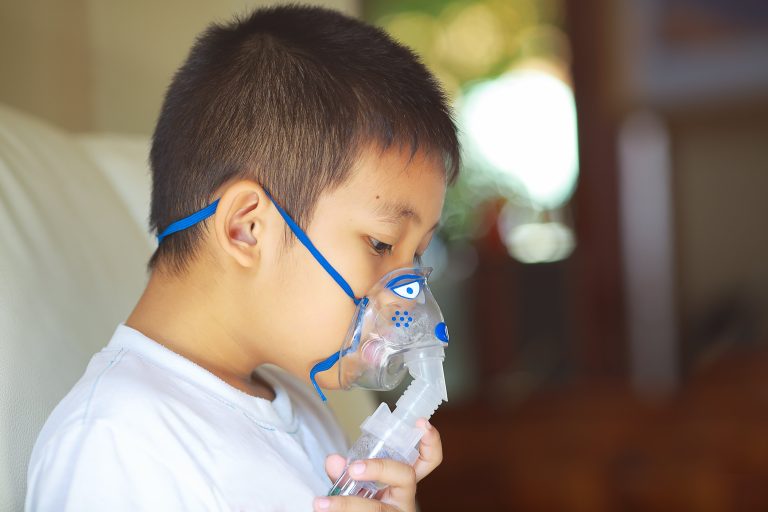Childhood Asthma - What to Do

Differential Diagnosis
It’s important to note that childhood asthma symptoms can sometimes overlap with other respiratory conditions. Paediatricians will consider and rule out these conditions as a part of the diagnostic process. Some of the conditions that may need differentiation from asthma include:
- Acute Bronchiolitis or Bronchitis: These often presents with coughing and wheezing, similar to asthma. However, these are typically a short-term condition caused by a viral or bacterial infection.
- Allergies: Allergic reactions can lead to wheezing and other asthma-like symptoms. Allergy testing may be necessary to identify potential triggers.
- Other Causes: Structural abnormalities of the airways and large blood vessels, gastro oesophageal reflux, foreign bodies, immunodeficiencies and other lung diseases
Understanding Childhood Asthma
One common issue that many parents encounter is childhood asthma. While it is a common condition, it can be complex and often challenging to manage. With a healthy child, one can play, run, and breathe effortlessly with no sign of respiratory distress. However, this is not the case for children with untreated asthma.
Asthma is a chronic lung condition affecting the airways, resulting in cough, wheeze or breathing difficulties. It often starts in childhood and can persist into adulthood.
Exploring the Causes of Childhood Asthma
The causes of asthma in children are a complex interplay of genetic and environmental factors. It’s essential to delve into these factors to gain a deeper understanding.
- Genetic Predisposition: If there’s a family history of asthma or other allergies e.g allergic rhinitis , eczema, food allergies, children are more likely to develop the condition. While studies are still in progress regarding specific genetic markers, it’s clear that asthma tends to run in families.
- Environmental Triggers: Exposure to allergens and irritants, such as pollen, house dust mites, pet dander, and tobacco smoke, can trigger asthma or worsen pre-existing symptoms. Avoiding these triggers is essential to managing asthma effectively.
- Respiratory Infections: Early respiratory infections, particularly during infancy, can increase the likelihood of developing asthma. It’s essential to ensure that children receive proper care and treatment when dealing with respiratory infections.
- Immune System Development: The developing immune system of a child may influence asthma development. Research suggests that early exposure to certain infections and microbes may help reduce the risk of asthma. Breastfeeding, for example, may provide some protective effects.
- Hygiene Hypothesis: Some studies have suggested that excessive cleanliness and reduced exposure to certain microbes in early childhood may increase the risk of developing asthma. This hypothesis highlights the importance of a balanced approach to hygiene.
Recognising Signs and Symptoms
Childhood asthma can manifest with various symptoms, possibly varying from one child to another. Common signs include:
- Coughing: Often worse at night or triggered by exercise / vigorous play
- Wheezing: Audible whistling sounds during breathing.
- Shortness of Breath: Children may have trouble catching their breath.
- Chest Tightness: A sensation of pressure or discomfort in the chest.
- Sleep Disturbances: Coughing or breathlessness may disrupt a child’s sleep.
Diagnosis of Child Asthma
When a child presents with symptoms that suggest asthma, a paediatrician will perform a thorough evaluation to make an accurate diagnosis. The diagnosis typically includes:
- Medical History: A detailed assessment of your child’s health history, including any family history of asthma or allergies.
- Physical Examination: Paediatrician will conduct a physical examination to listen for wheezing and other respiratory sounds as well as check for other associated allergic conditions .
- Lung Function Tests: Spirometry and other lung tests can assess how good your child’s lung function is.
- Other tests: Allergy tests, Chest X rays and other relevant tests for proper assessment

Management of Childhood Asthma in Singapore
Managing childhood asthma is a crucial aspect of ensuring your child’s well-being. In Singapore, padiatricians are well-equipped to address the specific needs of children with asthma. The management of childhood asthma typically involves a combination of medication and lifestyle adjustments, such as:
- Medication Management:
- Bronchodilators: These medications help relax the airway muscles, easing your child’s breathing during an asthma attack.
- Anti-Inflammatory Medications: These drugs, often inhaled corticosteroids, help reduce airway inflammation and prevent asthma symptoms.
- Allergen immunotherapy: This is a medical treatment that can make your body less sensitive to substances that trigger flare ups of asthma or allergic rhinitis
- Biologics: In some cases, biologic medications can help alleviate severe asthma and its associated allergies e.g eczema . These medications target specific molecules involved in the allergy .
- Asthma Action Plan:
- Work closely with your padiatricians to create a personalised asthma action plan for your child. This plan outlines specific steps to take during an asthma attack and guides daily management.
- Make sure you and your child understand how to follow the action plan. Education is essential to effective asthma management.
- Lifestyle Adjustments:
- Identify and Avoid Triggers: Recognise allergens and irritants that can trigger asthma symptoms. Common triggers include, house dust mites, pet dander, and tobacco smoke. Take steps to minimise exposure.
- Night-Time Solutions: Asthma attacks at night can be particularly distressing. Consider these strategies:
- Elevate the head of your child’s bed to help with breathing.
- Ensure the bedroom is well-ventilated and free from potential allergens.
- Consider using air purifiers to improve air quality.
- Follow the prescribed medication regimen.
- Regular Exercise: Encourage your child to stay active. Regular physical activity helps improve lung function and overall health. However, ensure compliance with your child’s asthma action plan before and after exercise.
- Nutrition: A balanced diet contributes to your child’s overall health. Getting the necessary nutrients can support their immune system and overall well-being.
- Education and Monitoring:
- Regular check-ups with your paediatrician are essential to monitor your child’s asthma. These check-ups allow for necessary adjustments to the asthma action plan.
- Education is an ongoing process for you and your child to understand the condition and the importance of adhering to the action plan.
- Emergency Preparedness:
- Be prepared for asthma attacks. Keep necessary medications and the asthma action plan easily accessible.
- Educate family members, caregivers, and your child’s school about your child’s asthma action plan to ensure a coordinated response if an emergency occurs.
- Emotional Support:
- Dealing with a chronic condition can be emotionally challenging, especially for children. Offer emotional support and encourage your child to communicate their feelings.
Conclusion
Childhood asthma is a manageable condition with the correct knowledge and support. Your child can lead a healthy and active life despite the challenges. Remember that SBCC Baby and Child Clinic (Asthma, Lung, Sleep & Allergy) is here to guide you on this journey.









